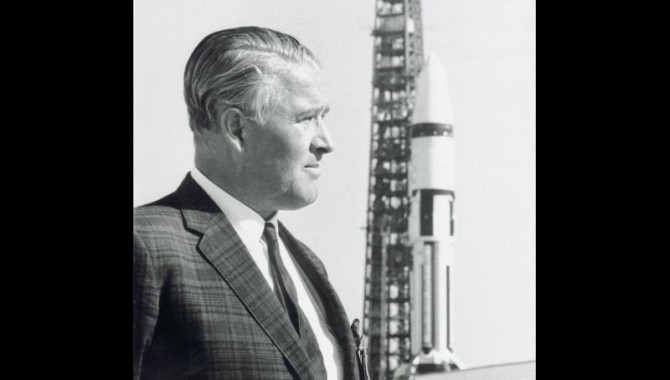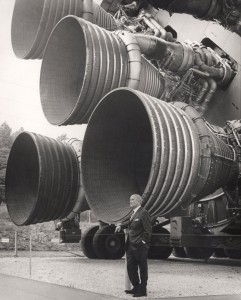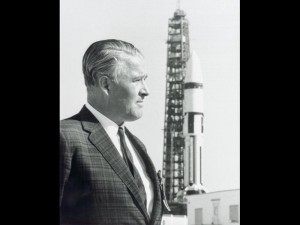
By Bob Ward
“Rocket scientist” Wernher von Braun remains a controversial figure. Even today, thirty-six years since his retirement from NASA and almost twenty-nine years after he departed planet Earth at the age of just sixty-five, the German-born engineer and physicist—and one-time enemy of the United States and its allies—still stands as an intriguing, dynamic, complex human being.
 Dr. Wernher Magnus Maximilian von Braun was the Superstar of Space of his day. He was rivaled only by some of the earliest astronauts and a bit later by a cool customer named Neil Armstrong. In von Braun’s case, the adulation was not universal.
Dr. Wernher Magnus Maximilian von Braun was the Superstar of Space of his day. He was rivaled only by some of the earliest astronauts and a bit later by a cool customer named Neil Armstrong. In von Braun’s case, the adulation was not universal.
Still, he had a passion for life along with his passion for rocketry and space exploration. It shone through in his work and all his communications. He was a communicator—in a voluble stream of speeches, conversations, briefings, press conferences, testimony, books, articles, technical papers, reports, correspondence, and patent applications. He helped turn much of his lifelong dream into reality, beginning in Germany, and then, for fully half his life, in America. To those who knew him well, von Braun was a larger-than-life, near-mythic figure, and yet also a fallible, feet-of-clay mortal.
He was the director of NASA’s George C. Marshall Space Flight Center for its first ten years of existence, and earlier the civilian technical head of the space-history-making Army Ballistic Missile Agency, both at Redstone Arsenal. Before that, he served for thirteen years as the German Army’s missile R&D civilian chief. He closed out his career with a largely frustrating two and a half years at NASA Headquarters as the Agency’s master long-range planner, and then an upbeat stint with Fairchild Industries in Maryland followed by a drawn-out death from cancer.
I began getting to know Dr. von Braun casually in 1957, the year the space age dawned, as a young and green daily newspaper reporter in Huntsville, Alabama. We got somewhat better acquainted over the ensuing years in “Rocket City, USA” and in his last years with NASA in Washington. I tried hard to maintain a journalist’s objectivity about him and keep a professional distance, but he was impressive. He became all the more imposing to me later, long after his death, through my seven years of researching and writing the 2005 biography, Dr. Space: The Life of Wernher von Braun.
He was, simply, a genius—as a technology leader, visionary, and as an inspiration to his various so-called “teams” in wartime, peacetime, and during the Cold War. Former astronaut, U.S. senator, and astronaut-again John Glenn told me in a 1999 interview that his longtime friend ranked as a modern renaissance man who possessed a “curiosity about everything around him.”
Von Braun had a hyperactive, almost compulsive sense of humor, and he used it in countless ways. He lightened the mood for his “board” meetings of laboratory directors and the rest of his management hierarchy with a joke or two. At the launch site, he often broke the tension with some witticism. He warmed up his 1950s audiences for speeches outside the South by apologizing “for my accent,” then grinning and adding, “I’m from Alabama.”
He would protest, “I’ve never considered myself a genius— and my wife is always ready to attest to this fact!” And in the 1950s and 1960s, when others might suggest their rocket-and- space success record showed his team’s German nucleus was “smarter” than everybody else, he would demur: “It’s not that we’re geniuses. It’s just that we old timers have been working on these things so long, we’ve had twelve more years to make mistakes and learn from them!”
Von Braun, born in 1912, an instant baron as the middle son of aristocratic Prussian parents, was a fast-walking, fast-talking bundle of contradictions. Brilliant as a youth, he became distracted and flunked math and physics. Sent off to boarding school and turned on academically in his early teens by visions of rocket ships in space, he earned degrees in mechanical and aeronautical engineering, plus a doctorate in physics, by age twenty-two. He had been named the civilian chief of the German Army’s rocket program two years earlier, before Adolf Hitler gained power. By age twenty-five he was the civilian technical director of the Wehrmacht side of the Peenemünde rocket R&D base on the Baltic seacoast. (The Luftwaffe ran the other side.)
This paradox of a bold, starry-eyed space cadet was one of the most ultra-conservative of engineers. A blend of visionary and realist, with a natural optimistic bent, he nonetheless inclined to move ahead only in safe, measured, incremental steps. He insisted on testing, testing, and testing again, down to the last component of the last subsystem.
Admiral Alan Shepard, a von Braun admirer, went to his grave believing he would have been the first human—not just the first American—in space, if only von Braun had not ordered just one more chimpanzee flight-test of Mercury-Redstone. That caution allowed the Soviet Union to send cosmonaut Yuri Gagarin into space in the spring of 1961, immediately before Shepard went up. Yet Shepard did have a safe flight aboard a souped-up U.S. Army “Jupiter-C” Redstone missile, as did Mercury astronaut “Gus” Grissom soon afterward. (A decade later, Project Apollo astronaut Shepard caught another flawless ride atop a von Braun launch vehicle—the somewhat larger Saturn V—to the lunar surface.)
Visionary as he was, in the practical world of engineering von Braun strongly preferred the tried and proven. His conservatism showed also in the matter of rocket propellants. Because of liquid hydrogen’s dangerous volatility, he had to be forced to use it as fuel in Saturn vehicle upper stages during Apollo. But he readily admitted later that it was the right decision, because of its greater propulsive punch to the pound. Likewise, he had to be ordered into an “all-up” launch mode for Saturn V—starting with the first unmanned test flight—if Apollo was to meet its deadline. That meant, of course, that all stages had to be flown “live” on every flight. Von Braun later acknowledged the rightness of that decision, too.
Von Braun’s deliberate, step-by-step approach resulted also in the successful orbiting of America’s first space satellite, Explorer 1, on the last day of January 1958. An insistence on perfection led to an unprecedented thirty-two successful Saturn heavy-lift vehicle launches out of thirty-two attempts between 1961 and 1975. Von Braun preached perfection and demanded perfection. Long years of experience had taught him that anything less spelled disaster.
When the relatively apolitical German Army’s revolutionary, 46-foot-tall, 200-mile-range V-2 missile was ordered prematurely into mass-production by the Hitler regime in autumn of 1943, six of every ten flight-test missiles exploded on the launch pad or failed in mid-flight. The V-2 was not fired operationally by German troops until September 1944—after the Allies’ D-Day invasion at Normandy.
Under the fascist dictatorship, Wernher von Braun was a member of the Nazi party, having waited almost five years after Hitler came to power before signing up. Under heavy pressure, he later accepted an officer’s commission—essentially honorary—in Heinrich Himmler’s brutal SS corps. Without question, von Braun was a prominent member of the Third Reich at least peripherally connected with the underground, SS-run, forced-labor, main V-2 factory, with its atrociously high mortality rate. Yet this living, breathing paradox soon became America’s perennial “Patriot of the Year” and “Scientist of the Year,” although certainly not in everyone’s minds.
It had not hurt von Braun’s case, after he and about 120 of his fellow German rocketeers transferred to the United States in 1945–46, that he had been arrested early in 1944 by Himmler’s Gestapo secret police, imprisoned on political charges of treason, and placed on trial for his life.
Spies had reported the rocket-meister saying he was more interested in exploring space than developing weapons; they had also overheard him denigrating certain Nazi big-wigs. He had further been accused of keeping his fast, four-seat, personal Messerschmidt aircraft gassed up at Peenemünde and handy for an escape to England with all the V-2 secrets. He was sprung in mid-trial by direct order of Hitler, thanks to intercession by the rocket Wunderkind’s commanding general, Walter Dornberger, and one of his patrons in the Nazi hierarchy, Albert Speer, archenemy of Himmler. Hitler acted on the probably questionable grounds that the V-2 program would collapse without von Braun.
As with the R&D problems of the V-2 and its predecessor, test-bed German rockets, the U.S. Army’s Redstone missile endured a less-than-perfect performance record early on in its history. This 200-mile, nuclear-capable weapon was the first major new development project assigned to the von Braun team in this country in the early 1950s. Launch-pad failure followed launch-pad failure after three years of work.
Witnessing one catastrophic Redstone explosion at Cape Canaveral, the scientist’s boss, Major General H. N. Toftoy, asked, “Wernher, why did that rocket explode?” Von Braun said the answer must await analysis of data. Toftoy persisted, finally questioning whether the German had “any idea why it exploded?” Von Braun fired back: “Yes. It exploded because the s.o.b. blew up!”
Von Braun had learned long before that close-knit teamwork and honest communication were the keys to eventual success. A classic example occurred with another Redstone mid-flight test failure. Telemetry data showed all systems had performed well until a precise point. This enabled troubleshooters to localize the probable source. The suspected area had been checked and rechecked during lab tests. Finally, the likeliest explanation was accepted, and corrective action ordered.
Then an engineer with the firing group asked to see him. The engineer explained that during pre-launch preps, he had tightened a certain connection for good measure. In so doing, he had touched a contact and drawn a spark. But since the system later checked out well, he had not paid any attention to it. Now that everybody was talking about that apparatus, he just wanted von Braun to know. A quick study showed that this was indeed the answer, and the planned “remedial action” was canceled. Von Braun sent a bottle of good champagne to the engineer. He wanted everyone to know that honesty pays off, even at the risk of incriminating oneself.
 In America, aerospace leader von Braun was competitive and aggressive in seeking programs, projects, and budget dollars for his agency. He tended to seize the moment. The very night that Sputnik went up, Eisenhower administration Secretary of Defense-designate Neil McElroy was visiting at Redstone Arsenal with von Braun, his commanding general, John Bruce Medaris, and other Army brass. Within a month, the von Braun team and its partners got the go-ahead to prepare and launch America’s first satellite. They did so in less than ninety days, having earlier made under-the-table preparations.
In America, aerospace leader von Braun was competitive and aggressive in seeking programs, projects, and budget dollars for his agency. He tended to seize the moment. The very night that Sputnik went up, Eisenhower administration Secretary of Defense-designate Neil McElroy was visiting at Redstone Arsenal with von Braun, his commanding general, John Bruce Medaris, and other Army brass. Within a month, the von Braun team and its partners got the go-ahead to prepare and launch America’s first satellite. They did so in less than ninety days, having earlier made under-the-table preparations.
When NASA was being created, von Braun sought to have the lion’s share of responsibilities based in Huntsville. And when Agency roles and missions for the space shuttle effort were being considered by Headquarters, he proposed that Marshall be lead center for almost everything, including central program management.
Two brief stories shed more light on aspects of von Braun’s management style and philosophy. One involves Marshall Center’s old “neutral buoyancy simulator.” Von Braun had the 33-by-35-foot water tank built on the sly and on the cheap in the 1960s, using in-house welders and funds borrowed from various accounts. It had its own “temporary” building. It proved a valuable tool for space flight hardware engineering design, evaluation, and eventually astronaut EVA training. It was also a great public-relations boon—a prime visitor attraction. Von Braun had not wanted to go through Congress and endure the inevitable restrictions on its use, so he called this huge structure a piece of “equipment,” not a “facility.” Eventually he was found out, and Congress did apply restrictions. The ploy reflected his philosophy of “better to ask forgiveness than permission.” As he told his inner circle at Marshall: “You build the facility first, then take the slap on the wrist. But you have the facility. They are not going to burn it.”
Von Braun tended to be a decisive, action-oriented manager. He detested bureaucratic indecision. When Hurricane Camille ravaged the Gulf of Mexico Coast and the Marshall-managed Mississippi Test Facility in 1969, its manager called urgently for help. A Marshall management staffer suggested the center send down a team to survey the critical needs. Von Braun said, “They don’t need a survey! They know what they need. We’re going to get a relief convoy together in the morning, and we are going down there and help!” The Marshall Center convoy arrived on the scene before the National Guard.
Von Braun was far from a perfect manager. He tended to hold overlong meetings, was considered too compassionate to reprimand or discipline wayward staffers (and usually had his chief longtime deputy, Eberhard Rees, do it for him), and was loathe to deny his management hierarchy unlimited access to him.
At one point, thirty-eight managers at Marshall had direct access to him between the weekly “board” meetings. An American-born insider finally persuaded him to appoint an R&D overlord to whom the majority would routinely report. After heated debate, von Braun directed the group to choose one from its number as the Uber-boss. The director was going on a holiday trip with his wife, and he said, “I won’t come back until I see the ‘white smoke’ of agreement.” The team acquiesced, selecting Hermann Weidner for the superchief’s role. Thereafter, von Braun would introduce him as “my pope,” chosen by his cardinals, the lab bosses.
The engineer-scientist could not, or would not, operate a dictation machine or a VCR, or learn how to adjust a color television set. A retainer of virtually all the knowledge he was ever exposed to, von Braun sometimes had trouble remembering to pick up his car-pool riders, buy the groceries his wife Maria told him to get at the market, or put on a belt or matching socks. When traveling, he never carried money, credit cards, or checks, leaving it to others, usually his assistants, to pay the bills and tips.
When the V-2 finally flew successfully on October 3, 1942, Hitler made the paradoxical von Braun an honorary “Research Professor,” a title he proudly emblazoned on his stationery at Peenemünde. He liked his colleagues there to address him as “Professor,” yet he never formally taught anywhere, aside from occasional guest lectures on campuses in America and abroad. But he was a teacher most of his adult life. When a Marshall Center delegation visited the Palomar Observatory in the late 1960s, a California university astronomer gave a lecture on the subject of white dwarfs. This inspired von Braun later that evening to give an all-night lecture on astronomy to his associates back in his quarters.
And once in the mid-1960s, a Marshall contingent traveling by Lear jet across Kansas at 41,000 feet had to fly around the giant meteorological phenomenon known as an anvil cloud. Von Braun left the cockpit and proceeded to give a young engineer a learned discourse on anvil clouds.
As a space leader, von Braun was quite the political operative, and he had warm relationships with national political figures ranging from President John F. Kennedy to NASA Administrator Tom Paine to Texas Congressman Olin “Tiger” Teague, longtime chair of the House space subcommittee. The rocket scientist worked at cultivating personal political relationships. He was a willing, popular, enthusiastic, but straight-shooting congressional witness. He went on countless hunting trips with politicians. He rolled out the red carpet for them at Marshall Center.
Given his past in Nazi Germany, it was unknown how the image of this human paradox would fare in the twenty- first century. Aviation Week & Space Technology coordinated a worldwide survey in 2003 for the centennial of man’s first powered flight, to determine the “Top 100 Stars of Aerospace” history. More than a million ballots came in from industry professionals in 180 countries. The results put him first among world space figures. In the overall category, he came in second, behind the Wright brothers. Walter Cronkite compared von Braun to Columbus. He said that, just as 500 years afterward we remember Columbus’s voyages of discovery as the supreme events of that time, so, too, will people 500 years hence remember the Apollo missions to the Moon as the crowning human achievement of the twentieth century. Cronkite observed that, while earthlings of the twenty-fifth century will undoubtedly fixate on the daring exploits of Armstrong, Aldrin, Collins, and their successor lunarnauts, Apollo’s engineers would also be prominently remembered: “[People then] will recognize it as an engineering feat. And when they do, they will fix on von Braun as certainly one of the greatest space engineering pioneers.”







